Organisational Behaviour Report: Sainsbury's Culture and Motivation
VerifiedAdded on 2021/02/20
|10
|3245
|32
Report
AI Summary
This report examines the organizational behavior of Sainsbury's, a major UK retail chain. It begins by identifying Sainsbury's culture using Handy's model, exploring power, role, task, and person cultures, with a focus on role culture. The report then analyzes how communication, using transactional and Shannon-Weaver models, enhances organizational effectiveness. It further evaluates the role of culture in employee motivation, applying ERG theory and Herzberg's two-factor theory to understand employee needs and motivation factors. Finally, the report assesses how Sainsbury's utilizes its organizational culture to achieve success, providing a comprehensive overview of the company's approach to organizational behavior.
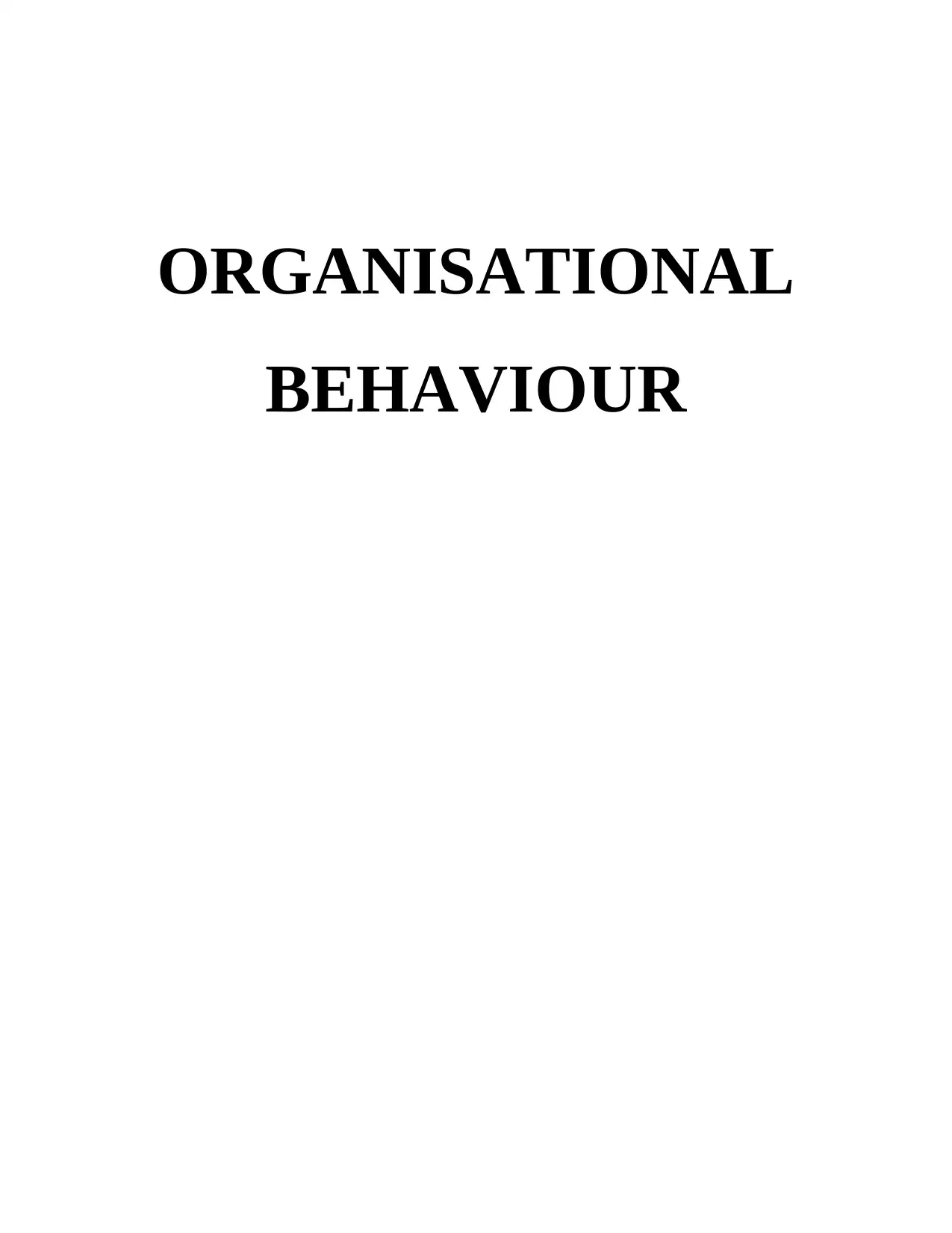
ORGANISATIONAL
BEHAVIOUR
BEHAVIOUR
Paraphrase This Document
Need a fresh take? Get an instant paraphrase of this document with our AI Paraphraser
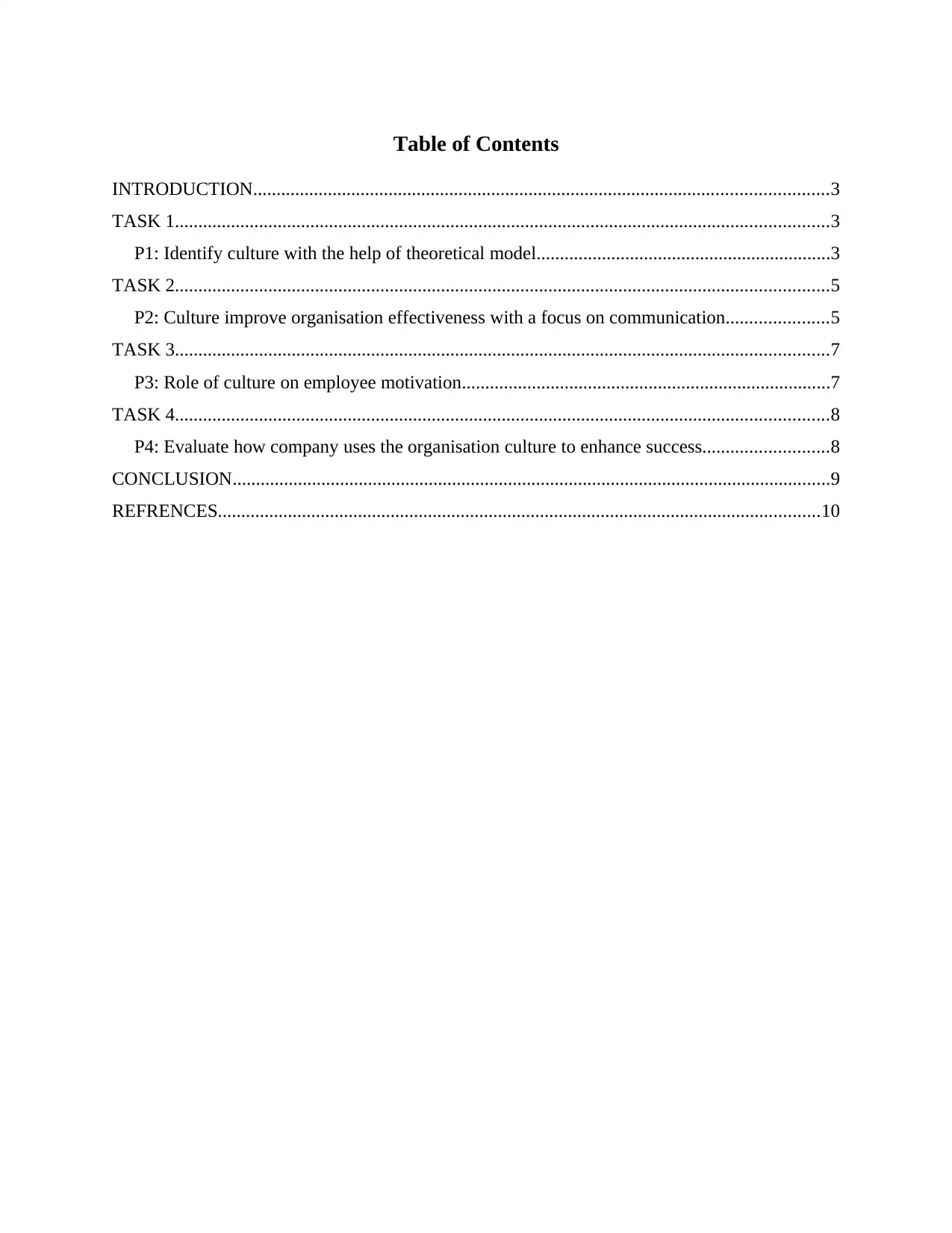
Table of Contents
INTRODUCTION...........................................................................................................................3
TASK 1............................................................................................................................................3
P1: Identify culture with the help of theoretical model...............................................................3
TASK 2............................................................................................................................................5
P2: Culture improve organisation effectiveness with a focus on communication......................5
TASK 3............................................................................................................................................7
P3: Role of culture on employee motivation...............................................................................7
TASK 4............................................................................................................................................8
P4: Evaluate how company uses the organisation culture to enhance success...........................8
CONCLUSION................................................................................................................................9
REFRENCES.................................................................................................................................10
INTRODUCTION...........................................................................................................................3
TASK 1............................................................................................................................................3
P1: Identify culture with the help of theoretical model...............................................................3
TASK 2............................................................................................................................................5
P2: Culture improve organisation effectiveness with a focus on communication......................5
TASK 3............................................................................................................................................7
P3: Role of culture on employee motivation...............................................................................7
TASK 4............................................................................................................................................8
P4: Evaluate how company uses the organisation culture to enhance success...........................8
CONCLUSION................................................................................................................................9
REFRENCES.................................................................................................................................10
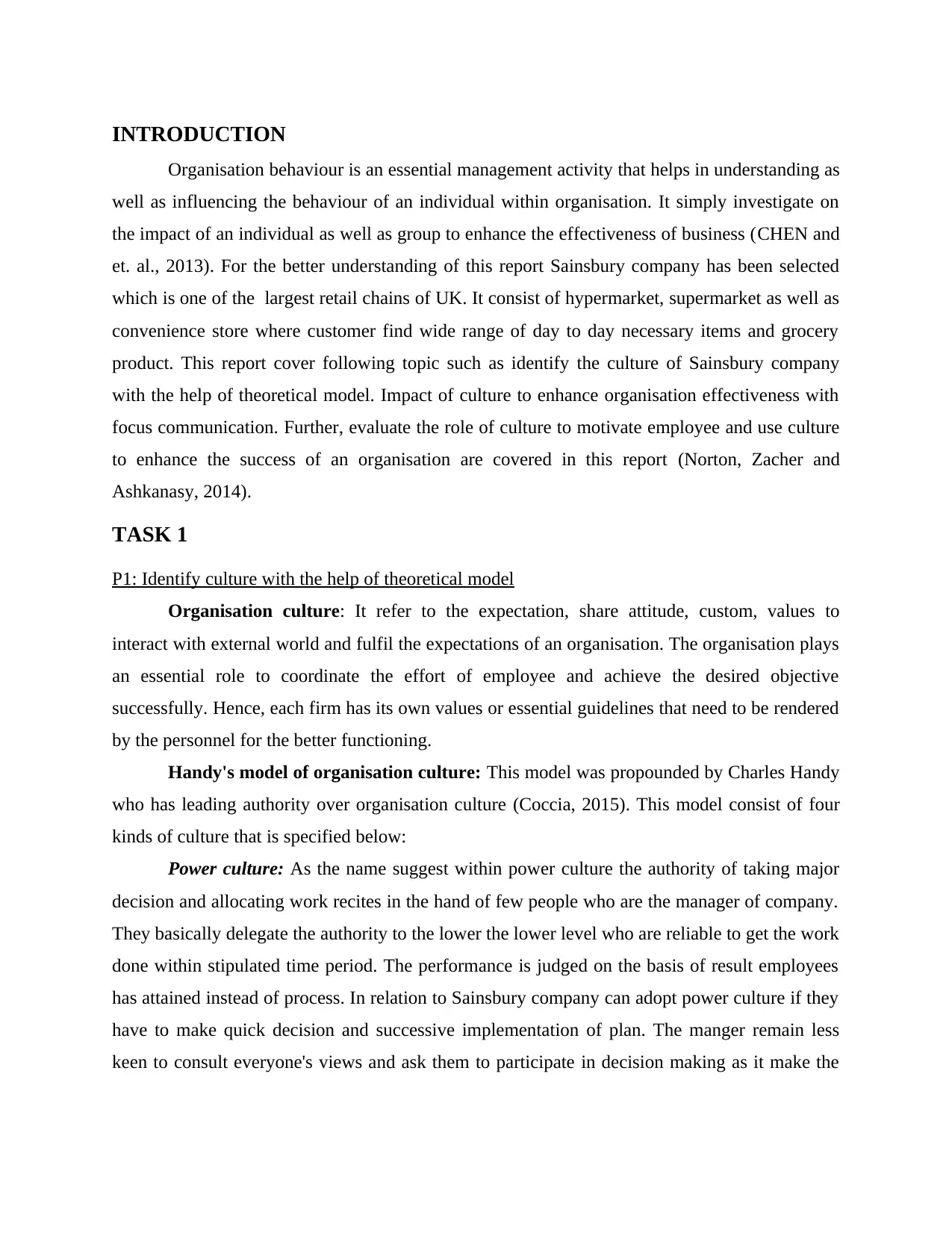
INTRODUCTION
Organisation behaviour is an essential management activity that helps in understanding as
well as influencing the behaviour of an individual within organisation. It simply investigate on
the impact of an individual as well as group to enhance the effectiveness of business (CHEN and
et. al., 2013). For the better understanding of this report Sainsbury company has been selected
which is one of the largest retail chains of UK. It consist of hypermarket, supermarket as well as
convenience store where customer find wide range of day to day necessary items and grocery
product. This report cover following topic such as identify the culture of Sainsbury company
with the help of theoretical model. Impact of culture to enhance organisation effectiveness with
focus communication. Further, evaluate the role of culture to motivate employee and use culture
to enhance the success of an organisation are covered in this report (Norton, Zacher and
Ashkanasy, 2014).
TASK 1
P1: Identify culture with the help of theoretical model
Organisation culture: It refer to the expectation, share attitude, custom, values to
interact with external world and fulfil the expectations of an organisation. The organisation plays
an essential role to coordinate the effort of employee and achieve the desired objective
successfully. Hence, each firm has its own values or essential guidelines that need to be rendered
by the personnel for the better functioning.
Handy's model of organisation culture: This model was propounded by Charles Handy
who has leading authority over organisation culture (Coccia, 2015). This model consist of four
kinds of culture that is specified below:
Power culture: As the name suggest within power culture the authority of taking major
decision and allocating work recites in the hand of few people who are the manager of company.
They basically delegate the authority to the lower the lower level who are reliable to get the work
done within stipulated time period. The performance is judged on the basis of result employees
has attained instead of process. In relation to Sainsbury company can adopt power culture if they
have to make quick decision and successive implementation of plan. The manger remain less
keen to consult everyone's views and ask them to participate in decision making as it make the
Organisation behaviour is an essential management activity that helps in understanding as
well as influencing the behaviour of an individual within organisation. It simply investigate on
the impact of an individual as well as group to enhance the effectiveness of business (CHEN and
et. al., 2013). For the better understanding of this report Sainsbury company has been selected
which is one of the largest retail chains of UK. It consist of hypermarket, supermarket as well as
convenience store where customer find wide range of day to day necessary items and grocery
product. This report cover following topic such as identify the culture of Sainsbury company
with the help of theoretical model. Impact of culture to enhance organisation effectiveness with
focus communication. Further, evaluate the role of culture to motivate employee and use culture
to enhance the success of an organisation are covered in this report (Norton, Zacher and
Ashkanasy, 2014).
TASK 1
P1: Identify culture with the help of theoretical model
Organisation culture: It refer to the expectation, share attitude, custom, values to
interact with external world and fulfil the expectations of an organisation. The organisation plays
an essential role to coordinate the effort of employee and achieve the desired objective
successfully. Hence, each firm has its own values or essential guidelines that need to be rendered
by the personnel for the better functioning.
Handy's model of organisation culture: This model was propounded by Charles Handy
who has leading authority over organisation culture (Coccia, 2015). This model consist of four
kinds of culture that is specified below:
Power culture: As the name suggest within power culture the authority of taking major
decision and allocating work recites in the hand of few people who are the manager of company.
They basically delegate the authority to the lower the lower level who are reliable to get the work
done within stipulated time period. The performance is judged on the basis of result employees
has attained instead of process. In relation to Sainsbury company can adopt power culture if they
have to make quick decision and successive implementation of plan. The manger remain less
keen to consult everyone's views and ask them to participate in decision making as it make the
⊘ This is a preview!⊘
Do you want full access?
Subscribe today to unlock all pages.

Trusted by 1+ million students worldwide
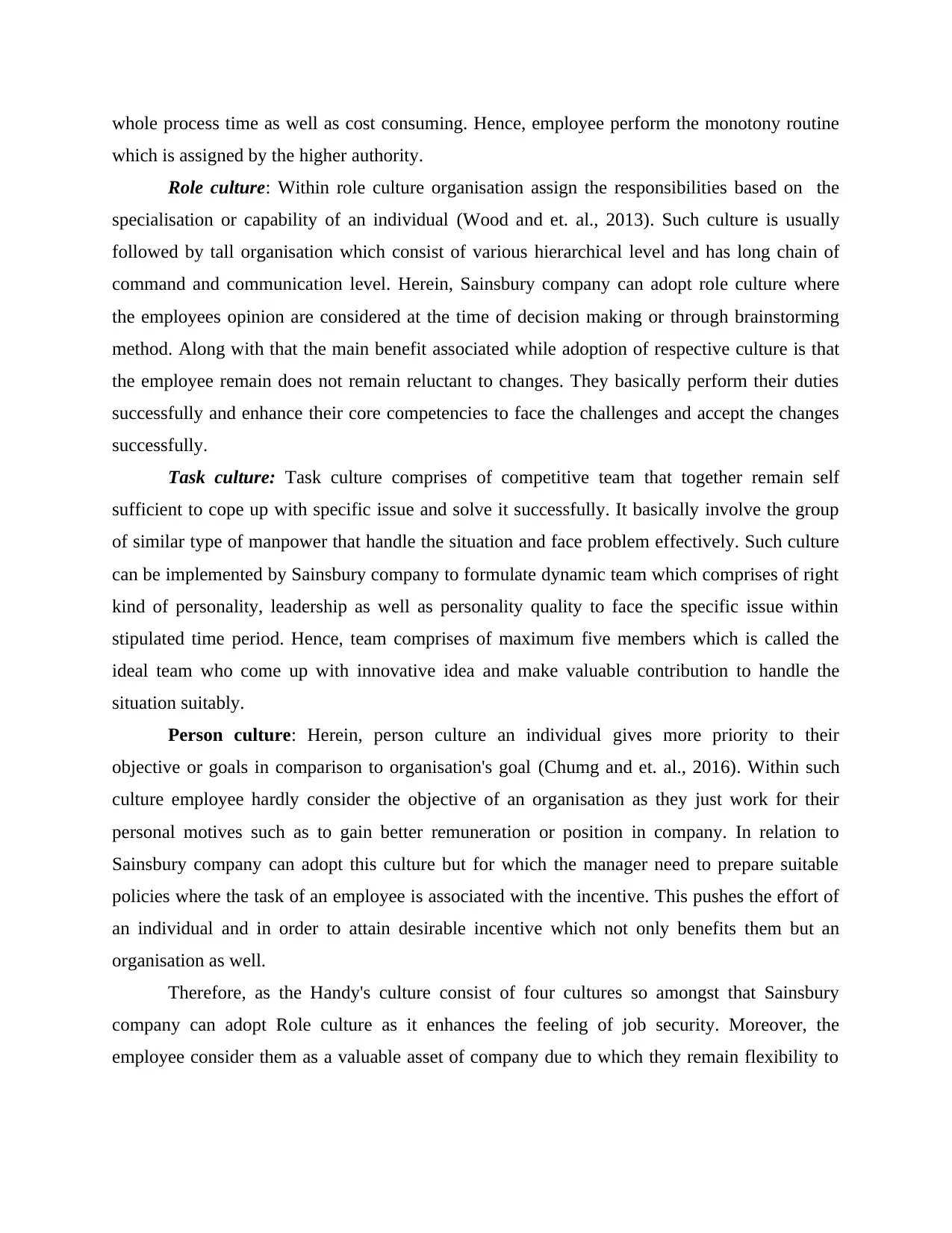
whole process time as well as cost consuming. Hence, employee perform the monotony routine
which is assigned by the higher authority.
Role culture: Within role culture organisation assign the responsibilities based on the
specialisation or capability of an individual (Wood and et. al., 2013). Such culture is usually
followed by tall organisation which consist of various hierarchical level and has long chain of
command and communication level. Herein, Sainsbury company can adopt role culture where
the employees opinion are considered at the time of decision making or through brainstorming
method. Along with that the main benefit associated while adoption of respective culture is that
the employee remain does not remain reluctant to changes. They basically perform their duties
successfully and enhance their core competencies to face the challenges and accept the changes
successfully.
Task culture: Task culture comprises of competitive team that together remain self
sufficient to cope up with specific issue and solve it successfully. It basically involve the group
of similar type of manpower that handle the situation and face problem effectively. Such culture
can be implemented by Sainsbury company to formulate dynamic team which comprises of right
kind of personality, leadership as well as personality quality to face the specific issue within
stipulated time period. Hence, team comprises of maximum five members which is called the
ideal team who come up with innovative idea and make valuable contribution to handle the
situation suitably.
Person culture: Herein, person culture an individual gives more priority to their
objective or goals in comparison to organisation's goal (Chumg and et. al., 2016). Within such
culture employee hardly consider the objective of an organisation as they just work for their
personal motives such as to gain better remuneration or position in company. In relation to
Sainsbury company can adopt this culture but for which the manager need to prepare suitable
policies where the task of an employee is associated with the incentive. This pushes the effort of
an individual and in order to attain desirable incentive which not only benefits them but an
organisation as well.
Therefore, as the Handy's culture consist of four cultures so amongst that Sainsbury
company can adopt Role culture as it enhances the feeling of job security. Moreover, the
employee consider them as a valuable asset of company due to which they remain flexibility to
which is assigned by the higher authority.
Role culture: Within role culture organisation assign the responsibilities based on the
specialisation or capability of an individual (Wood and et. al., 2013). Such culture is usually
followed by tall organisation which consist of various hierarchical level and has long chain of
command and communication level. Herein, Sainsbury company can adopt role culture where
the employees opinion are considered at the time of decision making or through brainstorming
method. Along with that the main benefit associated while adoption of respective culture is that
the employee remain does not remain reluctant to changes. They basically perform their duties
successfully and enhance their core competencies to face the challenges and accept the changes
successfully.
Task culture: Task culture comprises of competitive team that together remain self
sufficient to cope up with specific issue and solve it successfully. It basically involve the group
of similar type of manpower that handle the situation and face problem effectively. Such culture
can be implemented by Sainsbury company to formulate dynamic team which comprises of right
kind of personality, leadership as well as personality quality to face the specific issue within
stipulated time period. Hence, team comprises of maximum five members which is called the
ideal team who come up with innovative idea and make valuable contribution to handle the
situation suitably.
Person culture: Herein, person culture an individual gives more priority to their
objective or goals in comparison to organisation's goal (Chumg and et. al., 2016). Within such
culture employee hardly consider the objective of an organisation as they just work for their
personal motives such as to gain better remuneration or position in company. In relation to
Sainsbury company can adopt this culture but for which the manager need to prepare suitable
policies where the task of an employee is associated with the incentive. This pushes the effort of
an individual and in order to attain desirable incentive which not only benefits them but an
organisation as well.
Therefore, as the Handy's culture consist of four cultures so amongst that Sainsbury
company can adopt Role culture as it enhances the feeling of job security. Moreover, the
employee consider them as a valuable asset of company due to which they remain flexibility to
Paraphrase This Document
Need a fresh take? Get an instant paraphrase of this document with our AI Paraphraser
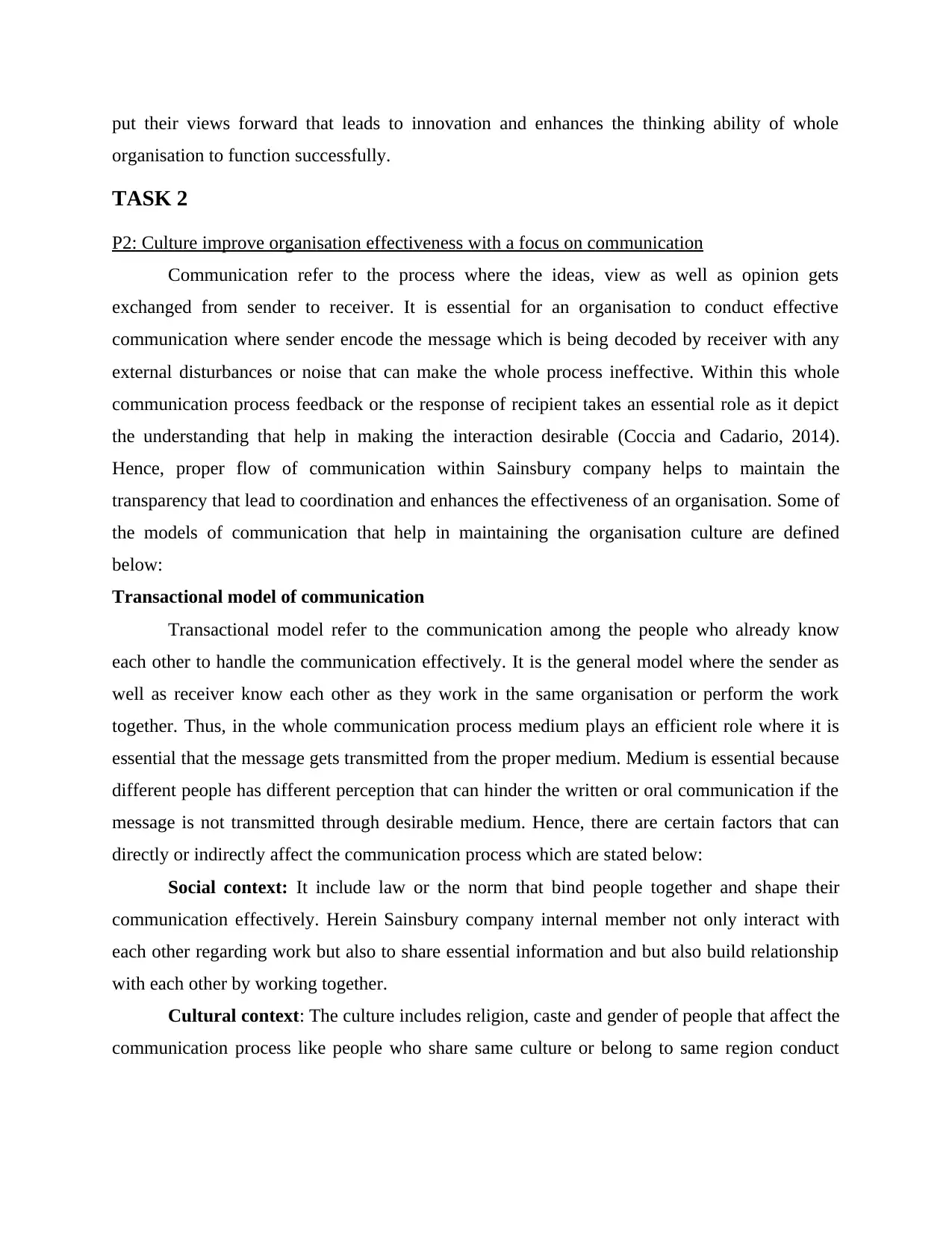
put their views forward that leads to innovation and enhances the thinking ability of whole
organisation to function successfully.
TASK 2
P2: Culture improve organisation effectiveness with a focus on communication
Communication refer to the process where the ideas, view as well as opinion gets
exchanged from sender to receiver. It is essential for an organisation to conduct effective
communication where sender encode the message which is being decoded by receiver with any
external disturbances or noise that can make the whole process ineffective. Within this whole
communication process feedback or the response of recipient takes an essential role as it depict
the understanding that help in making the interaction desirable (Coccia and Cadario, 2014).
Hence, proper flow of communication within Sainsbury company helps to maintain the
transparency that lead to coordination and enhances the effectiveness of an organisation. Some of
the models of communication that help in maintaining the organisation culture are defined
below:
Transactional model of communication
Transactional model refer to the communication among the people who already know
each other to handle the communication effectively. It is the general model where the sender as
well as receiver know each other as they work in the same organisation or perform the work
together. Thus, in the whole communication process medium plays an efficient role where it is
essential that the message gets transmitted from the proper medium. Medium is essential because
different people has different perception that can hinder the written or oral communication if the
message is not transmitted through desirable medium. Hence, there are certain factors that can
directly or indirectly affect the communication process which are stated below:
Social context: It include law or the norm that bind people together and shape their
communication effectively. Herein Sainsbury company internal member not only interact with
each other regarding work but also to share essential information and but also build relationship
with each other by working together.
Cultural context: The culture includes religion, caste and gender of people that affect the
communication process like people who share same culture or belong to same region conduct
organisation to function successfully.
TASK 2
P2: Culture improve organisation effectiveness with a focus on communication
Communication refer to the process where the ideas, view as well as opinion gets
exchanged from sender to receiver. It is essential for an organisation to conduct effective
communication where sender encode the message which is being decoded by receiver with any
external disturbances or noise that can make the whole process ineffective. Within this whole
communication process feedback or the response of recipient takes an essential role as it depict
the understanding that help in making the interaction desirable (Coccia and Cadario, 2014).
Hence, proper flow of communication within Sainsbury company helps to maintain the
transparency that lead to coordination and enhances the effectiveness of an organisation. Some of
the models of communication that help in maintaining the organisation culture are defined
below:
Transactional model of communication
Transactional model refer to the communication among the people who already know
each other to handle the communication effectively. It is the general model where the sender as
well as receiver know each other as they work in the same organisation or perform the work
together. Thus, in the whole communication process medium plays an efficient role where it is
essential that the message gets transmitted from the proper medium. Medium is essential because
different people has different perception that can hinder the written or oral communication if the
message is not transmitted through desirable medium. Hence, there are certain factors that can
directly or indirectly affect the communication process which are stated below:
Social context: It include law or the norm that bind people together and shape their
communication effectively. Herein Sainsbury company internal member not only interact with
each other regarding work but also to share essential information and but also build relationship
with each other by working together.
Cultural context: The culture includes religion, caste and gender of people that affect the
communication process like people who share same culture or belong to same region conduct
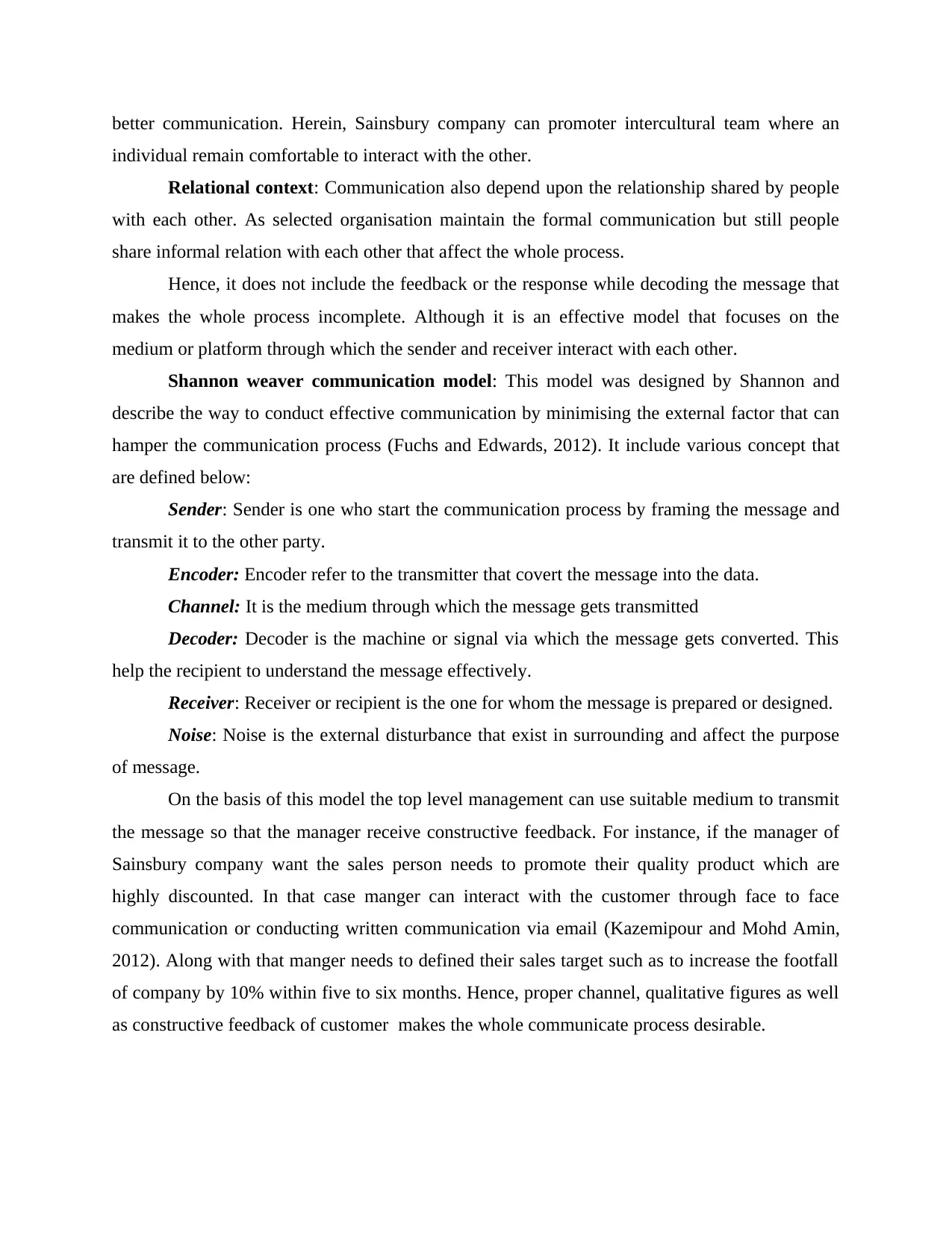
better communication. Herein, Sainsbury company can promoter intercultural team where an
individual remain comfortable to interact with the other.
Relational context: Communication also depend upon the relationship shared by people
with each other. As selected organisation maintain the formal communication but still people
share informal relation with each other that affect the whole process.
Hence, it does not include the feedback or the response while decoding the message that
makes the whole process incomplete. Although it is an effective model that focuses on the
medium or platform through which the sender and receiver interact with each other.
Shannon weaver communication model: This model was designed by Shannon and
describe the way to conduct effective communication by minimising the external factor that can
hamper the communication process (Fuchs and Edwards, 2012). It include various concept that
are defined below:
Sender: Sender is one who start the communication process by framing the message and
transmit it to the other party.
Encoder: Encoder refer to the transmitter that covert the message into the data.
Channel: It is the medium through which the message gets transmitted
Decoder: Decoder is the machine or signal via which the message gets converted. This
help the recipient to understand the message effectively.
Receiver: Receiver or recipient is the one for whom the message is prepared or designed.
Noise: Noise is the external disturbance that exist in surrounding and affect the purpose
of message.
On the basis of this model the top level management can use suitable medium to transmit
the message so that the manager receive constructive feedback. For instance, if the manager of
Sainsbury company want the sales person needs to promote their quality product which are
highly discounted. In that case manger can interact with the customer through face to face
communication or conducting written communication via email (Kazemipour and Mohd Amin,
2012). Along with that manger needs to defined their sales target such as to increase the footfall
of company by 10% within five to six months. Hence, proper channel, qualitative figures as well
as constructive feedback of customer makes the whole communicate process desirable.
individual remain comfortable to interact with the other.
Relational context: Communication also depend upon the relationship shared by people
with each other. As selected organisation maintain the formal communication but still people
share informal relation with each other that affect the whole process.
Hence, it does not include the feedback or the response while decoding the message that
makes the whole process incomplete. Although it is an effective model that focuses on the
medium or platform through which the sender and receiver interact with each other.
Shannon weaver communication model: This model was designed by Shannon and
describe the way to conduct effective communication by minimising the external factor that can
hamper the communication process (Fuchs and Edwards, 2012). It include various concept that
are defined below:
Sender: Sender is one who start the communication process by framing the message and
transmit it to the other party.
Encoder: Encoder refer to the transmitter that covert the message into the data.
Channel: It is the medium through which the message gets transmitted
Decoder: Decoder is the machine or signal via which the message gets converted. This
help the recipient to understand the message effectively.
Receiver: Receiver or recipient is the one for whom the message is prepared or designed.
Noise: Noise is the external disturbance that exist in surrounding and affect the purpose
of message.
On the basis of this model the top level management can use suitable medium to transmit
the message so that the manager receive constructive feedback. For instance, if the manager of
Sainsbury company want the sales person needs to promote their quality product which are
highly discounted. In that case manger can interact with the customer through face to face
communication or conducting written communication via email (Kazemipour and Mohd Amin,
2012). Along with that manger needs to defined their sales target such as to increase the footfall
of company by 10% within five to six months. Hence, proper channel, qualitative figures as well
as constructive feedback of customer makes the whole communicate process desirable.
⊘ This is a preview!⊘
Do you want full access?
Subscribe today to unlock all pages.

Trusted by 1+ million students worldwide
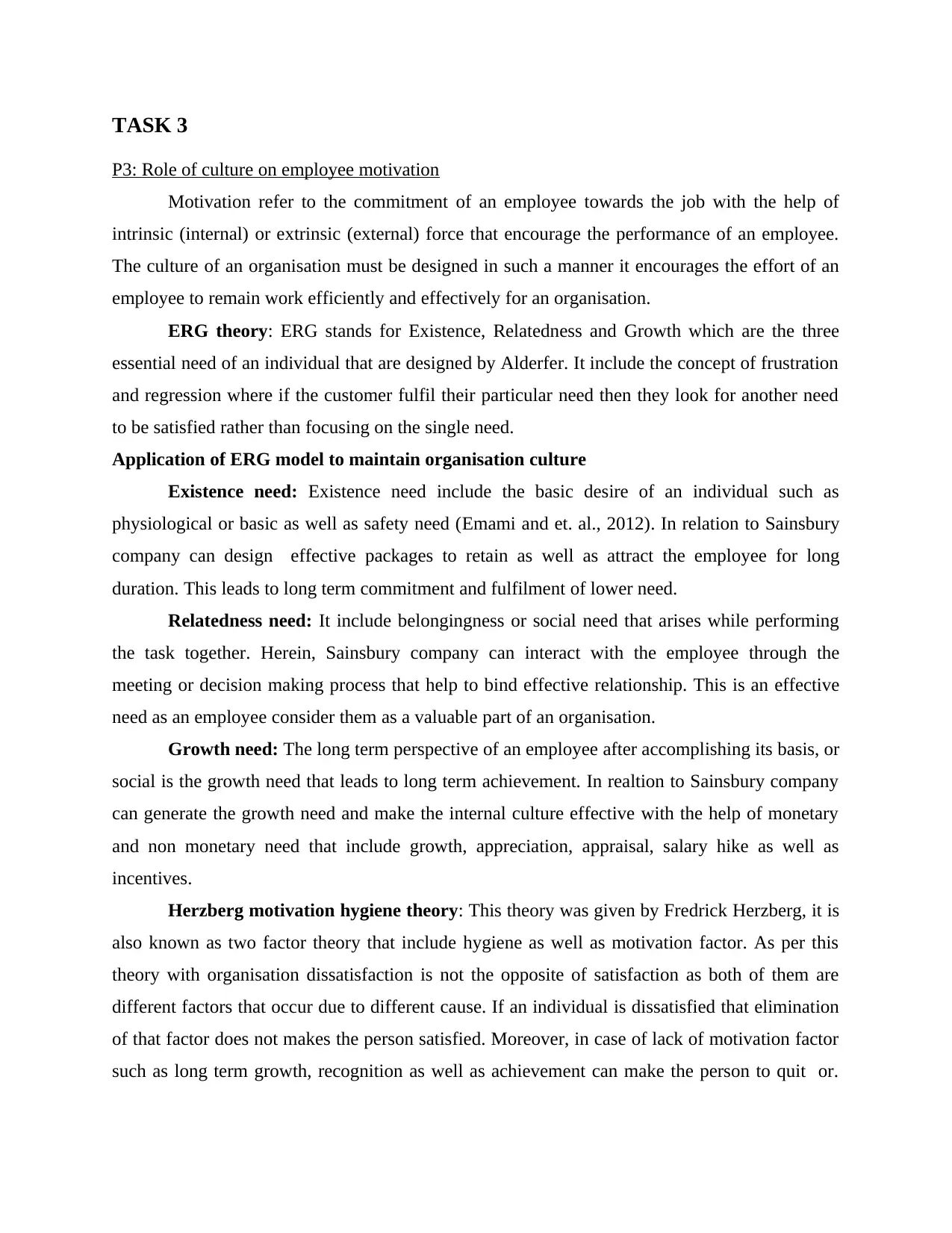
TASK 3
P3: Role of culture on employee motivation
Motivation refer to the commitment of an employee towards the job with the help of
intrinsic (internal) or extrinsic (external) force that encourage the performance of an employee.
The culture of an organisation must be designed in such a manner it encourages the effort of an
employee to remain work efficiently and effectively for an organisation.
ERG theory: ERG stands for Existence, Relatedness and Growth which are the three
essential need of an individual that are designed by Alderfer. It include the concept of frustration
and regression where if the customer fulfil their particular need then they look for another need
to be satisfied rather than focusing on the single need.
Application of ERG model to maintain organisation culture
Existence need: Existence need include the basic desire of an individual such as
physiological or basic as well as safety need (Emami and et. al., 2012). In relation to Sainsbury
company can design effective packages to retain as well as attract the employee for long
duration. This leads to long term commitment and fulfilment of lower need.
Relatedness need: It include belongingness or social need that arises while performing
the task together. Herein, Sainsbury company can interact with the employee through the
meeting or decision making process that help to bind effective relationship. This is an effective
need as an employee consider them as a valuable part of an organisation.
Growth need: The long term perspective of an employee after accomplishing its basis, or
social is the growth need that leads to long term achievement. In realtion to Sainsbury company
can generate the growth need and make the internal culture effective with the help of monetary
and non monetary need that include growth, appreciation, appraisal, salary hike as well as
incentives.
Herzberg motivation hygiene theory: This theory was given by Fredrick Herzberg, it is
also known as two factor theory that include hygiene as well as motivation factor. As per this
theory with organisation dissatisfaction is not the opposite of satisfaction as both of them are
different factors that occur due to different cause. If an individual is dissatisfied that elimination
of that factor does not makes the person satisfied. Moreover, in case of lack of motivation factor
such as long term growth, recognition as well as achievement can make the person to quit or.
P3: Role of culture on employee motivation
Motivation refer to the commitment of an employee towards the job with the help of
intrinsic (internal) or extrinsic (external) force that encourage the performance of an employee.
The culture of an organisation must be designed in such a manner it encourages the effort of an
employee to remain work efficiently and effectively for an organisation.
ERG theory: ERG stands for Existence, Relatedness and Growth which are the three
essential need of an individual that are designed by Alderfer. It include the concept of frustration
and regression where if the customer fulfil their particular need then they look for another need
to be satisfied rather than focusing on the single need.
Application of ERG model to maintain organisation culture
Existence need: Existence need include the basic desire of an individual such as
physiological or basic as well as safety need (Emami and et. al., 2012). In relation to Sainsbury
company can design effective packages to retain as well as attract the employee for long
duration. This leads to long term commitment and fulfilment of lower need.
Relatedness need: It include belongingness or social need that arises while performing
the task together. Herein, Sainsbury company can interact with the employee through the
meeting or decision making process that help to bind effective relationship. This is an effective
need as an employee consider them as a valuable part of an organisation.
Growth need: The long term perspective of an employee after accomplishing its basis, or
social is the growth need that leads to long term achievement. In realtion to Sainsbury company
can generate the growth need and make the internal culture effective with the help of monetary
and non monetary need that include growth, appreciation, appraisal, salary hike as well as
incentives.
Herzberg motivation hygiene theory: This theory was given by Fredrick Herzberg, it is
also known as two factor theory that include hygiene as well as motivation factor. As per this
theory with organisation dissatisfaction is not the opposite of satisfaction as both of them are
different factors that occur due to different cause. If an individual is dissatisfied that elimination
of that factor does not makes the person satisfied. Moreover, in case of lack of motivation factor
such as long term growth, recognition as well as achievement can make the person to quit or.
Paraphrase This Document
Need a fresh take? Get an instant paraphrase of this document with our AI Paraphraser
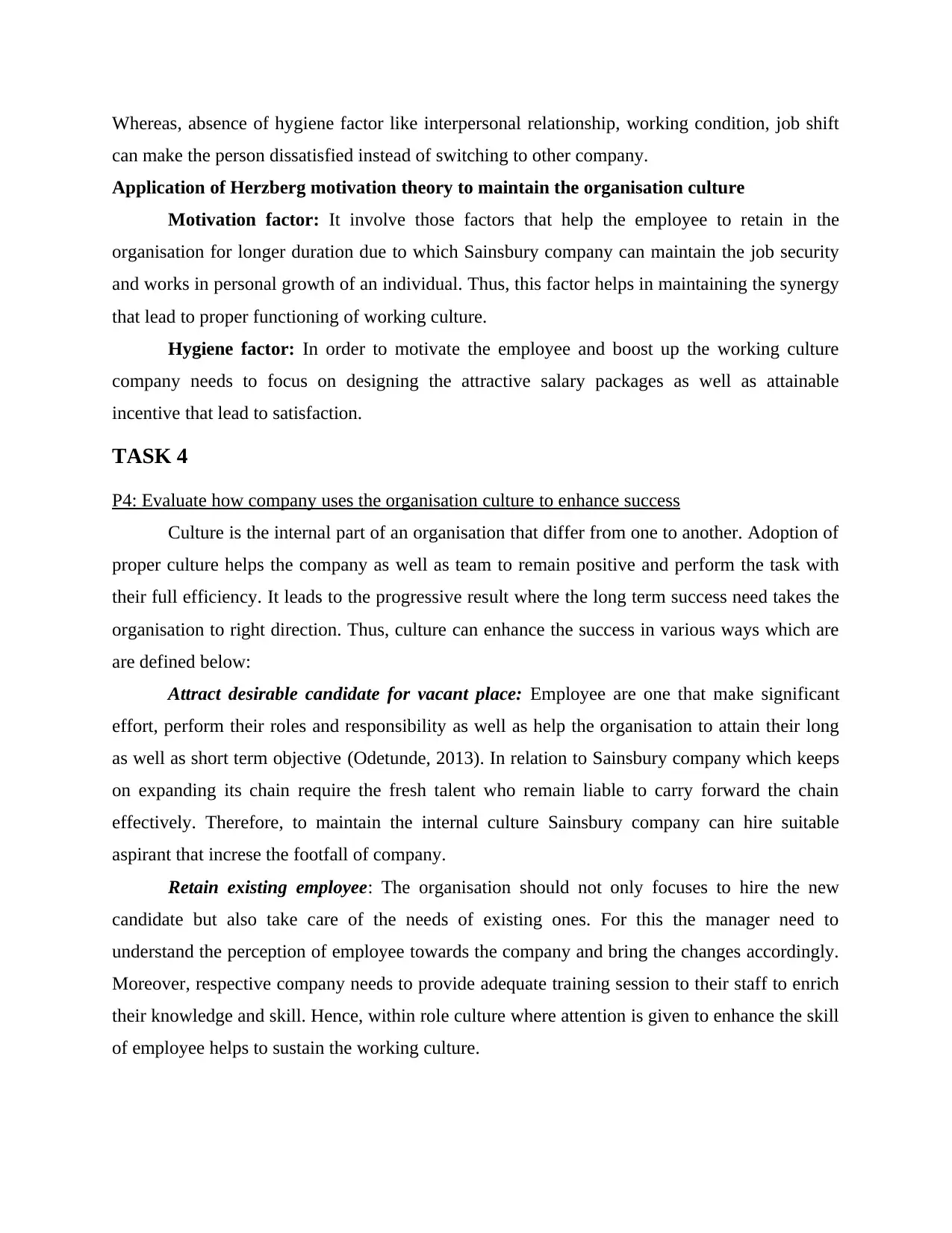
Whereas, absence of hygiene factor like interpersonal relationship, working condition, job shift
can make the person dissatisfied instead of switching to other company.
Application of Herzberg motivation theory to maintain the organisation culture
Motivation factor: It involve those factors that help the employee to retain in the
organisation for longer duration due to which Sainsbury company can maintain the job security
and works in personal growth of an individual. Thus, this factor helps in maintaining the synergy
that lead to proper functioning of working culture.
Hygiene factor: In order to motivate the employee and boost up the working culture
company needs to focus on designing the attractive salary packages as well as attainable
incentive that lead to satisfaction.
TASK 4
P4: Evaluate how company uses the organisation culture to enhance success
Culture is the internal part of an organisation that differ from one to another. Adoption of
proper culture helps the company as well as team to remain positive and perform the task with
their full efficiency. It leads to the progressive result where the long term success need takes the
organisation to right direction. Thus, culture can enhance the success in various ways which are
are defined below:
Attract desirable candidate for vacant place: Employee are one that make significant
effort, perform their roles and responsibility as well as help the organisation to attain their long
as well as short term objective (Odetunde, 2013). In relation to Sainsbury company which keeps
on expanding its chain require the fresh talent who remain liable to carry forward the chain
effectively. Therefore, to maintain the internal culture Sainsbury company can hire suitable
aspirant that increse the footfall of company.
Retain existing employee: The organisation should not only focuses to hire the new
candidate but also take care of the needs of existing ones. For this the manager need to
understand the perception of employee towards the company and bring the changes accordingly.
Moreover, respective company needs to provide adequate training session to their staff to enrich
their knowledge and skill. Hence, within role culture where attention is given to enhance the skill
of employee helps to sustain the working culture.
can make the person dissatisfied instead of switching to other company.
Application of Herzberg motivation theory to maintain the organisation culture
Motivation factor: It involve those factors that help the employee to retain in the
organisation for longer duration due to which Sainsbury company can maintain the job security
and works in personal growth of an individual. Thus, this factor helps in maintaining the synergy
that lead to proper functioning of working culture.
Hygiene factor: In order to motivate the employee and boost up the working culture
company needs to focus on designing the attractive salary packages as well as attainable
incentive that lead to satisfaction.
TASK 4
P4: Evaluate how company uses the organisation culture to enhance success
Culture is the internal part of an organisation that differ from one to another. Adoption of
proper culture helps the company as well as team to remain positive and perform the task with
their full efficiency. It leads to the progressive result where the long term success need takes the
organisation to right direction. Thus, culture can enhance the success in various ways which are
are defined below:
Attract desirable candidate for vacant place: Employee are one that make significant
effort, perform their roles and responsibility as well as help the organisation to attain their long
as well as short term objective (Odetunde, 2013). In relation to Sainsbury company which keeps
on expanding its chain require the fresh talent who remain liable to carry forward the chain
effectively. Therefore, to maintain the internal culture Sainsbury company can hire suitable
aspirant that increse the footfall of company.
Retain existing employee: The organisation should not only focuses to hire the new
candidate but also take care of the needs of existing ones. For this the manager need to
understand the perception of employee towards the company and bring the changes accordingly.
Moreover, respective company needs to provide adequate training session to their staff to enrich
their knowledge and skill. Hence, within role culture where attention is given to enhance the skill
of employee helps to sustain the working culture.
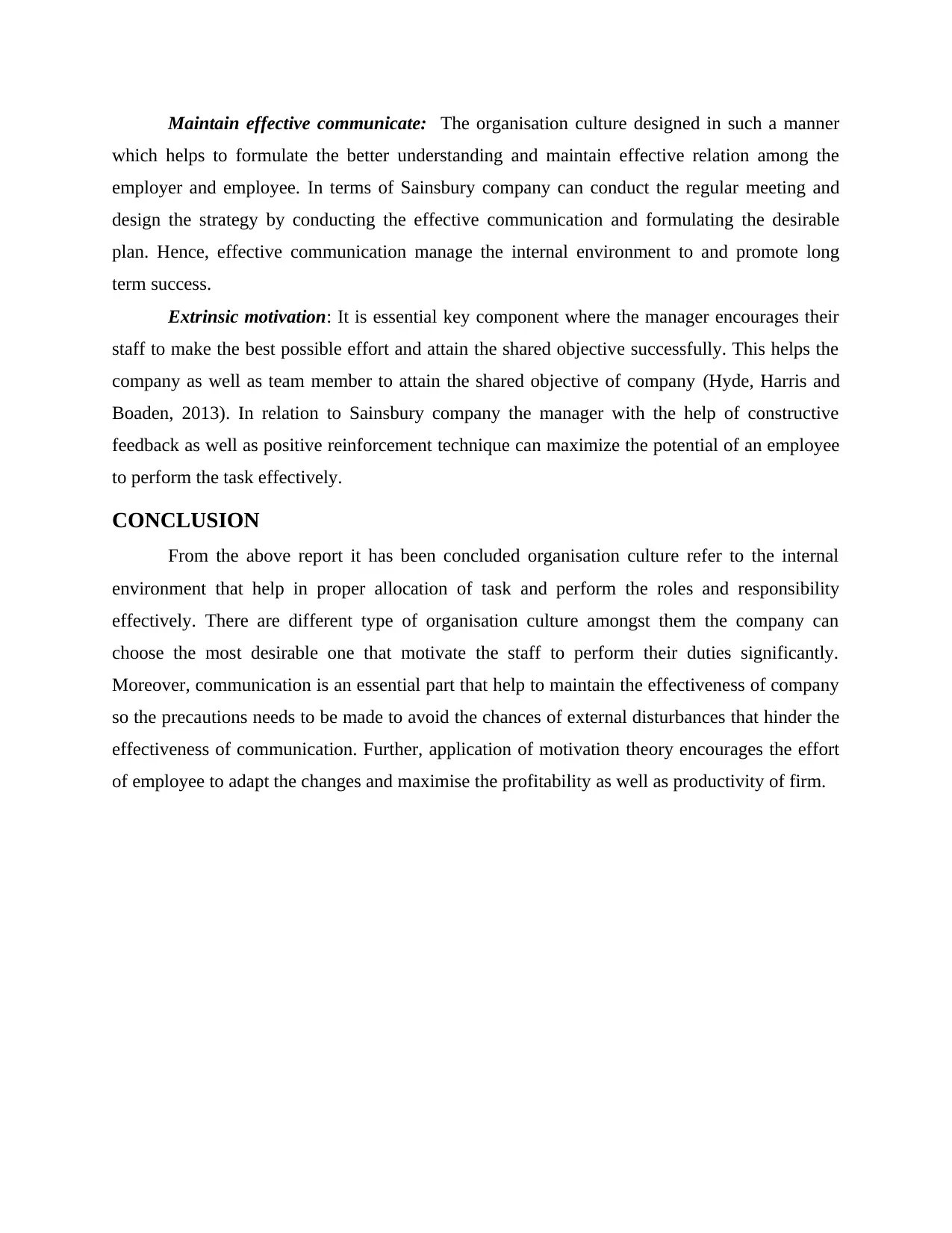
Maintain effective communicate: The organisation culture designed in such a manner
which helps to formulate the better understanding and maintain effective relation among the
employer and employee. In terms of Sainsbury company can conduct the regular meeting and
design the strategy by conducting the effective communication and formulating the desirable
plan. Hence, effective communication manage the internal environment to and promote long
term success.
Extrinsic motivation: It is essential key component where the manager encourages their
staff to make the best possible effort and attain the shared objective successfully. This helps the
company as well as team member to attain the shared objective of company (Hyde, Harris and
Boaden, 2013). In relation to Sainsbury company the manager with the help of constructive
feedback as well as positive reinforcement technique can maximize the potential of an employee
to perform the task effectively.
CONCLUSION
From the above report it has been concluded organisation culture refer to the internal
environment that help in proper allocation of task and perform the roles and responsibility
effectively. There are different type of organisation culture amongst them the company can
choose the most desirable one that motivate the staff to perform their duties significantly.
Moreover, communication is an essential part that help to maintain the effectiveness of company
so the precautions needs to be made to avoid the chances of external disturbances that hinder the
effectiveness of communication. Further, application of motivation theory encourages the effort
of employee to adapt the changes and maximise the profitability as well as productivity of firm.
which helps to formulate the better understanding and maintain effective relation among the
employer and employee. In terms of Sainsbury company can conduct the regular meeting and
design the strategy by conducting the effective communication and formulating the desirable
plan. Hence, effective communication manage the internal environment to and promote long
term success.
Extrinsic motivation: It is essential key component where the manager encourages their
staff to make the best possible effort and attain the shared objective successfully. This helps the
company as well as team member to attain the shared objective of company (Hyde, Harris and
Boaden, 2013). In relation to Sainsbury company the manager with the help of constructive
feedback as well as positive reinforcement technique can maximize the potential of an employee
to perform the task effectively.
CONCLUSION
From the above report it has been concluded organisation culture refer to the internal
environment that help in proper allocation of task and perform the roles and responsibility
effectively. There are different type of organisation culture amongst them the company can
choose the most desirable one that motivate the staff to perform their duties significantly.
Moreover, communication is an essential part that help to maintain the effectiveness of company
so the precautions needs to be made to avoid the chances of external disturbances that hinder the
effectiveness of communication. Further, application of motivation theory encourages the effort
of employee to adapt the changes and maximise the profitability as well as productivity of firm.
⊘ This is a preview!⊘
Do you want full access?
Subscribe today to unlock all pages.

Trusted by 1+ million students worldwide
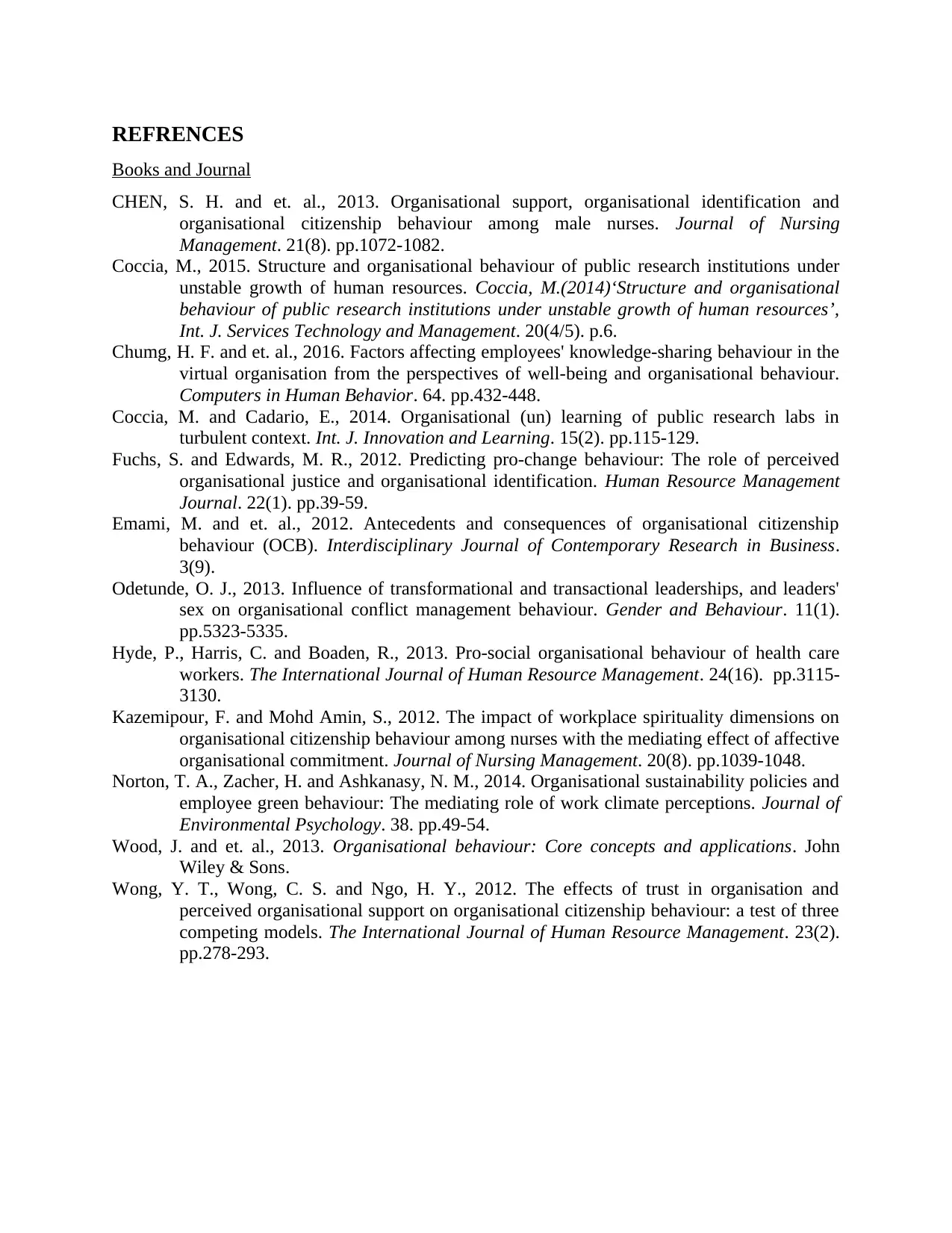
REFRENCES
Books and Journal
CHEN, S. H. and et. al., 2013. Organisational support, organisational identification and
organisational citizenship behaviour among male nurses. Journal of Nursing
Management. 21(8). pp.1072-1082.
Coccia, M., 2015. Structure and organisational behaviour of public research institutions under
unstable growth of human resources. Coccia, M.(2014)‘Structure and organisational
behaviour of public research institutions under unstable growth of human resources’,
Int. J. Services Technology and Management. 20(4/5). p.6.
Chumg, H. F. and et. al., 2016. Factors affecting employees' knowledge-sharing behaviour in the
virtual organisation from the perspectives of well-being and organisational behaviour.
Computers in Human Behavior. 64. pp.432-448.
Coccia, M. and Cadario, E., 2014. Organisational (un) learning of public research labs in
turbulent context. Int. J. Innovation and Learning. 15(2). pp.115-129.
Fuchs, S. and Edwards, M. R., 2012. Predicting pro‐change behaviour: The role of perceived
organisational justice and organisational identification. Human Resource Management
Journal. 22(1). pp.39-59.
Emami, M. and et. al., 2012. Antecedents and consequences of organisational citizenship
behaviour (OCB). Interdisciplinary Journal of Contemporary Research in Business.
3(9).
Odetunde, O. J., 2013. Influence of transformational and transactional leaderships, and leaders'
sex on organisational conflict management behaviour. Gender and Behaviour. 11(1).
pp.5323-5335.
Hyde, P., Harris, C. and Boaden, R., 2013. Pro-social organisational behaviour of health care
workers. The International Journal of Human Resource Management. 24(16). pp.3115-
3130.
Kazemipour, F. and Mohd Amin, S., 2012. The impact of workplace spirituality dimensions on
organisational citizenship behaviour among nurses with the mediating effect of affective
organisational commitment. Journal of Nursing Management. 20(8). pp.1039-1048.
Norton, T. A., Zacher, H. and Ashkanasy, N. M., 2014. Organisational sustainability policies and
employee green behaviour: The mediating role of work climate perceptions. Journal of
Environmental Psychology. 38. pp.49-54.
Wood, J. and et. al., 2013. Organisational behaviour: Core concepts and applications. John
Wiley & Sons.
Wong, Y. T., Wong, C. S. and Ngo, H. Y., 2012. The effects of trust in organisation and
perceived organisational support on organisational citizenship behaviour: a test of three
competing models. The International Journal of Human Resource Management. 23(2).
pp.278-293.
Books and Journal
CHEN, S. H. and et. al., 2013. Organisational support, organisational identification and
organisational citizenship behaviour among male nurses. Journal of Nursing
Management. 21(8). pp.1072-1082.
Coccia, M., 2015. Structure and organisational behaviour of public research institutions under
unstable growth of human resources. Coccia, M.(2014)‘Structure and organisational
behaviour of public research institutions under unstable growth of human resources’,
Int. J. Services Technology and Management. 20(4/5). p.6.
Chumg, H. F. and et. al., 2016. Factors affecting employees' knowledge-sharing behaviour in the
virtual organisation from the perspectives of well-being and organisational behaviour.
Computers in Human Behavior. 64. pp.432-448.
Coccia, M. and Cadario, E., 2014. Organisational (un) learning of public research labs in
turbulent context. Int. J. Innovation and Learning. 15(2). pp.115-129.
Fuchs, S. and Edwards, M. R., 2012. Predicting pro‐change behaviour: The role of perceived
organisational justice and organisational identification. Human Resource Management
Journal. 22(1). pp.39-59.
Emami, M. and et. al., 2012. Antecedents and consequences of organisational citizenship
behaviour (OCB). Interdisciplinary Journal of Contemporary Research in Business.
3(9).
Odetunde, O. J., 2013. Influence of transformational and transactional leaderships, and leaders'
sex on organisational conflict management behaviour. Gender and Behaviour. 11(1).
pp.5323-5335.
Hyde, P., Harris, C. and Boaden, R., 2013. Pro-social organisational behaviour of health care
workers. The International Journal of Human Resource Management. 24(16). pp.3115-
3130.
Kazemipour, F. and Mohd Amin, S., 2012. The impact of workplace spirituality dimensions on
organisational citizenship behaviour among nurses with the mediating effect of affective
organisational commitment. Journal of Nursing Management. 20(8). pp.1039-1048.
Norton, T. A., Zacher, H. and Ashkanasy, N. M., 2014. Organisational sustainability policies and
employee green behaviour: The mediating role of work climate perceptions. Journal of
Environmental Psychology. 38. pp.49-54.
Wood, J. and et. al., 2013. Organisational behaviour: Core concepts and applications. John
Wiley & Sons.
Wong, Y. T., Wong, C. S. and Ngo, H. Y., 2012. The effects of trust in organisation and
perceived organisational support on organisational citizenship behaviour: a test of three
competing models. The International Journal of Human Resource Management. 23(2).
pp.278-293.
1 out of 10
Related Documents
Your All-in-One AI-Powered Toolkit for Academic Success.
+13062052269
info@desklib.com
Available 24*7 on WhatsApp / Email
![[object Object]](/_next/static/media/star-bottom.7253800d.svg)
Unlock your academic potential
Copyright © 2020–2025 A2Z Services. All Rights Reserved. Developed and managed by ZUCOL.




